 אמנות בספריה
אמנות בספריה
 אמנות בספריה
אמנות בספריה
The library's collection of mathematical models includesThe models are exhibited permanently in the library at the entrance area.
- Schilling models of surfaces (in plaster)
- M.C. Escher kaleidocycles (in paper)
- Conic sections and polyhedra models (in plastic)
"Mathematical model" / Encyclopaedia Britannica Online.Physical mathematical models include reproductions of plane and solid geometric figures made of cardboard, wood, plastic, or other substances; models of conic sections, curves in space, or three-dimensional surfaces of various kinds made of wire, plaster, or thread strung from frames; and models of surfaces of higher order that make it possible to visualize abstract mathematical concepts. |
The Göttingen collection of mathematical models and instruments was developed to use physical models and experimental instruments in education and research. This model collection already had a long history when Hermann Amandus Schwarz and Felix Klein overtook the direction of the collection.The model collection was systematically modernized and completed for the education in geometry and geodesy under the direction of Klein. This collection was considered so important that Klein exhibited the models on the occasion of the World s Columbian Exposition 1893 in Chicago.
Most of the models were produced by Martin Schilling in Leipzig. The firm's catalogue of the firm catagorized the models into series. Each model is described and explained.
Martin Schilling : Catalog mathematischer Modelle für den höheren mathematischen Unterricht. 7. Aufl. Leipzig : Martin Schilling,1911.These models inspired artists, particularly Man Ray, who was inspired by the Mathematical models at the Institut Henri Poincaré, Paris, shown to him by the artist Max Ernst.
Man Ray - Human equations = מאן ריי משוואות אנושיות , an exhibit on his "Shakespearean Equations" was on display at the Israel Museum October 22, 2015-January 23, 2016. The exhibit included some models from our collection.Bibliography:
- Visualizing Mathematics - Online / Konrad Polthier
- Theory and history of geometric models / Irene Polo-Blanco. 2007 (Groningen : Academic Press Europe). - XIV, 175 p. : ill. ; 24 cm Proefschrift Rijksuniversiteit Groningen. ISBN 978-90-78927-01-3
The Library's collection of Schilling mathematical models
Prof. Felix Klein's personal collection was purchased in 1927 by Prof. Edmund Landau for the mathematics library.
This collection included some mathematical models made of gypsum (Prof. Klein had rearranged and added to the collection of mathematical models in Göttingen).
For more information, see: → Library's history.
Other collections of Schilling mathematical models
Collections of Schilling mathematical models exist in several mathematical institutions around the world. Some of the following websites also include additional information on the models and their classification. See also: Collections of mathematical models / Angela Vierling-Claassen, Department of Mathematics, Lesley University
- Besançon, France : Modèles mathématiques du Laboratoire de mathématiques de Besançon
- Harvard University : Mathematical models at the Harvard Mathematics Department : index
- Institut Henri Poincaré, Paris: Mathematical models
Between 1934-36, the mathematical objects at the Institut Henri Poincaré in Paris, were photographed by the artist Man Ray.- Karazin University in Kharkiv, Ukraine : Geometric models collection : The TouchGeometry Project
- Martin-Luther-Universität, Halle-Wittenberg, Germany / Institut für Mathematik / Didaktik der Mathematik : Sammlung Historischer mathematischer Modelle
- Mathematisches Institut (Göttingen, Germany) : Göttinger Sammlung mathematischer Modelle = Göttingen collection of mathematical models and instruments
- University of Dundee Museum : Mathematical models
- University of Groningen, The Netherlands : Mathematical models of surfaces
- University of Illinois : Altgeld Math models collection
| Click on a small image to see the larger picture |
|---|
| Schilling classification | Description in German from catalog | Library model | English description | More information from other collections |
|---|---|---|---|---|
| Series XVI, designed 1888 by Prof. E.R. Neovius Göttingen classification: A.I.g. Confocal systems. A confocal system describes conic sections with the same foci respectively their body of rotation. | ||||
| XVI no.1 | Ellipsoid mit drei Hauptschnitten und achtzehn Krümmungslinien |
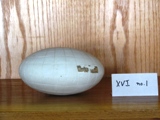
| Ellipsoid with three basic intersections and eighteen lines of curvature | University of Groningen |
| XVI no.4 | Einschaliges Hyperboloid |

| Single-leaf hyperboloid with a family of lines | Göttingen Model 388 |
| XVI no.5 | Zweischaliges Hyperboloid |

| Double-leaf hyperboloid | Göttingen Model 26 |
| XVI no.6 | Vereinigung eines Ellipsoids mit einem confocalen einschaligen Hyperboloid |

| Single-leaf hyperboloid and confocal ellipsoid Union of an ellipsoid with lines of curvature (coming from intersecting confocal quadrics) and a confocal single hyperboloid (with two families of lines) | Göttingen Model 27 |
| XVI no.7 | Vereinigung eines Ellipsoids mit einem confocalen zweischaligen Hyperboloid |

| Ellipsoid and confocal double-leaf hyperboloid Union of an ellipsoid with lines of curvature (coming from intersecting confocal quadrics) and a confocal double hyperboloid | Göttingen Model 29 |
| XVI no.8 | Vereinigung eines einschaligen Hyperboloids mit einem confocalen zweischaligen Hyperboloid |

| Single-leaf hyperboloid and confocal double-leaf ellipsoid. Union of a single hyperboloid with a confocal double hyperboloid | Göttingen Model 28 |
| XVI no.9 | Vereinigung eines Ellipsoids mit einem confocalen einschaligen und einem confocalen zweischaligen Hyperboloid |
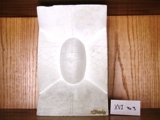
| Ellipsoid, confocal single- and double-leaf hyperboloid. Union of an ellipsoid with a confocal single hyperboloid and a confocal double hyperboloid | Göttingen Model 30 |
| Series XXIII, designed 1889 | ||||
| XXIII no.1b. | Das dreiaxige Ellipsoid mit Krümmungslinien |
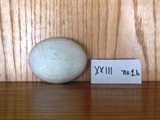
| Triaxial ellipsoid with lines of curvature | |
| XXIII no.3 | Das zweischalige Hyperboloid |
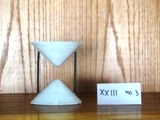
| Double hyperboloid | Mathematischer Modelle an der Technischen Universität Dresden |
| XXIII no.5 | Das hyperbolische Paraboloid |
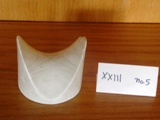
| Hyperbolic paraboloid with planar cut | Göttingen Model 7 |
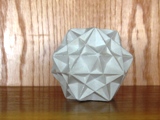
| Great ditrigonal icosidodecahedron | Gratrix.net | ||
- Also displayed in the library, polyhedral forms assembled from the book:
- M.C. Escher Kaleidozyklen / von Doris Schattschneider und Wallace Walker.
Berlin : Benedikt Taschen, 1990.
Translation of M.C. Escher kaleidocycles.

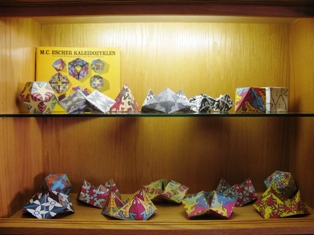
- More information:
- M.C. Escher / Wikipedia
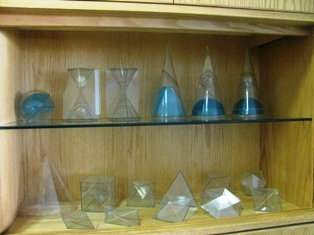
Models photographed by: Gila Manusovich-Shamir,
Jerusalem
© 2009, All rights reserved.